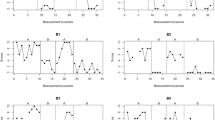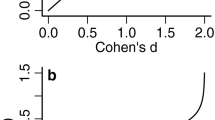Abstract
The statistical inference problem on effect size indices is addressed using a series of independent two-armed experiments from k arbitrary populations. The effect size parameter simply quantifies the difference between two groups. It is a meaningful index to be used when data are measured on different scales. In the context of bivariate statistical models, we define estimators of the effect size indices and propose large sample testing procedures to test the homogeneity of these indices. The null and non-null distributions of the proposed testing procedures are derived and their performance is evaluated via Monte Carlo simulation. Further, three types of interval estimation of the proposed indices are considered for both combined and uncombined data. Lower and upper confidence limits for the actual effect size indices are obtained and compared via bootstrapping. It is found that the length of the intervals based on the combined effect size estimator are almost half the length of the intervals based on the uncombined effect size estimators. Finally, we illustrate the proposed procedures for hypothesis testing and interval estimation using a real data set.
Similar content being viewed by others
References
Algina J, Keselman HJ (2003) Approximate confidence intervals for effect sizes. Edu Psychol Meas 63(4): 537–553
Al-Kandari N, BuHamra S, Ahmed SE (2005) Estimation and testing of effect size from arbitrary population. J Stat Comput Simul 75(12): 987–1001
Cohen J (1988) Statistical power analysis for the behavioral sciences, 2nd edn. Lawrence Erlbaum Assoc Inc., NJ
Glass GV, McGaw B, Smith M (1981) Meta analysis in social research. Sage, CA
Grissom R, Kim J (2005) Effect size for research: a broad practical approach. Lawrence Erlbaum Assoc Inc., NJ, pp 747–769
Hedges LV, Olkin I (1985) Statistical methods for meta-analysis. Academic Press, FL
Hutchinson TP, Lai CD (1990) Continuous bivariate distributions, emphasizing applications. Rumsby Scientific Publishing, South Australia
Lehmann EL (1999) Elements of large-sample theory. Springer, NY
Marshall AW, Olkin I (1967) A multivariate exponential distribution. J Am Stat Assoc 62: 30–44
Wilkinson L (1999) APA Task Force on Statistical Inference Statistical methods in psychology journals: guidelines and explanations. Am Psychol 54: 594–604
Valentine JC, Cooper H (2003) Effect size substantive interpretation guidelines: issues in the interpretation of effect sizes. What Works Clearinghouse, DC
Wilson RJ (1998) Australasian data and story library (OzDASL). www.statsci.org/data/oz/ms212.html
Author information
Authors and Affiliations
Corresponding author
Additional information
Professor Ahmed’s work was supported in part by NSERC grant.
Rights and permissions
About this article
Cite this article
BuHamra, S.S., Al-Kandari, N.M. & Ahmed, S.E. Inference on effect size indices from several two-armed experiments. Stat Papers 51, 775–787 (2010). https://doi.org/10.1007/s00362-008-0165-9
Received:
Revised:
Published:
Issue Date:
DOI: https://doi.org/10.1007/s00362-008-0165-9




